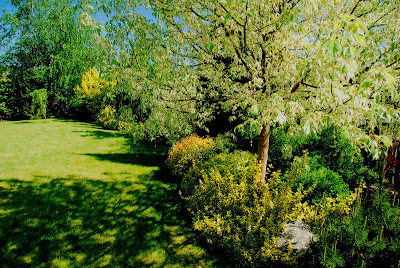After driving around with five summer tyres on the back seat of my Nissan Micra for over three weeks, I finally managed to leave work in time yesterday to get to the
wulkanizator (he closes at six) and have my winter tyres changed.
I pull into the forecourt, leave the car and pop into the office - empty. Then into the workshop - empty. I'm wandering around unsure of what to do. A man I don't recognise is polishing a newish Skoda Octavia on the forecourt. He asks me: "Why doesn't Sir ask me what Sir wants?" I reply: "Now hang on a second - Sir should be asking
me what
I want, not the other way round. How am I to know Sir works here? For all I know, Sir may be the proud owner of this newish Skoda Octavia, and by asking Sir to change my tyres, I'd be insulting Sir!"
At this moment, I realise (once again) that I am insufficiently assertive for the rough-and-tumble of everyday life in Poland. Brought up in cheerful, polite, respectful Britain, I expect service sector employees to know their place in society. Mindful of this, by way of
quid pro quo, I accord them with cheerful, polite, respectful condescension.
The above forecourt dialogue would look like this in (my idealised) Britain:
Employee: "May I help you, Sir?"
Me: "Of course you can! Could you change all my winter tyres for summer tyres while I wait?"
Employee: "Half a mo, Sir, just let me wipe the last of the wax off the Skoda an' I'll have your tyres changed in a jiffy!"
I should have handled the situation in Poland like this:
Me: "
Panie - zmieni mi Pan opony na letnie - dobrze?" ("Sir will change my tyres to summer ones - good?")
Employee: (sullenly tugging forelock) "
Dobrze."("Good.")
When these assertiveness situations happen to me, I immediately feel inadequate; even after ten years in Poland, I get tongue-tied, get my case-endings all wrong, hold back on
demanding what I want because I still feel that politeness gets you somewhere.
Another example from yesterday. My mobile rings; its the septic tank drainage company. They were booked to empty it, but a nice young lady tells me that all the ten cubic metre trucks are busy and that they can't make it until tomorrow. I politely explain that the septic tank has been overflowing since Sunday and every time anyone flushes the toilet, more smelly excrement spills out over the drive. Plus, Pani Zosia has come in specially to let the tanker in and out. "Sorry Sir, we can't make it today - that's that." So I phone my wife (who's having a stressful day anyway) and tell her this latest bit of bad news. "Let me sort this out" she says. Five minutes later she calls back to say that a truck is on its way right now to empty our septic tank. Now why couldn't
I manage that?
While I was waiting for my tyres to be changed, I went across the road to the Wild Bean Cafe at the BP petrol station for some late lunch. I ordered a beef burrito. First bite - scaldingly hot. Second bite - just right. Third bite - hmm... lukewarm. Fourth bite - decidedly cold. I stop. Should I ask the petrol station assistant to re-heat my half-eaten burrito? What should I do? I end up doing the English thing. Half my brain is telling me not to make a fuss, the other half is warning me of the dangers of eating partially cooked mincemeat. In the end, my desire to avoid a potential row wins out over considerations of hygiene. I finish the burrito. Fifth bite - glacial. Sixth bite - warmer. Final bite - OK. I wash it all down with coffee and drive home.
One hour later I'm on the bog, bitterly regretting having eaten that wretched burrito.
Flush, clean bowl,
flush again. It was indeed a good thing that my wife persuaded them to empty the septic tank.
At times like this I feel desperately uncomfortable in Poland.
Ten years and I've not been able to acquire the brusque toughness needed to get my own way in day-to-day transactions. After all, what's so difficult in saying "
To jest zimne. Pani to podgrzeje - dobrze?" ("This is cold. Madam will reheat this - good?")
This time last year:
Some welcome relief in the form of spring rain
 One of life's great pleasures; returning home on a warm spring evening to take in the pleasures of the garden at twilight time. The cares and woes of the day are put to one side, moments are spent in quiet contemplation of the sun's dying rays illuminating the trees as shadows lengthen.
One of life's great pleasures; returning home on a warm spring evening to take in the pleasures of the garden at twilight time. The cares and woes of the day are put to one side, moments are spent in quiet contemplation of the sun's dying rays illuminating the trees as shadows lengthen.







































 The speed and scale of the operation has amazed me; it was not long since my last walk here. The tracks have been thrown down the side of the embankment and the sidings below also ripped up. Below: Looking towards the buffers at the Nowa Iwiczna end of the line. Compare with
The speed and scale of the operation has amazed me; it was not long since my last walk here. The tracks have been thrown down the side of the embankment and the sidings below also ripped up. Below: Looking towards the buffers at the Nowa Iwiczna end of the line. Compare with 















